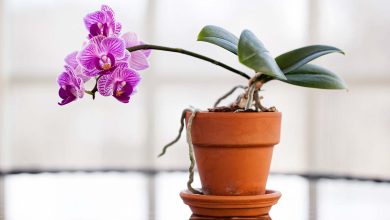Mistletoe: [Cultivation, Care, Irrigation, Substrate, Pests and Diseases]

Important points when planting Mistletoe
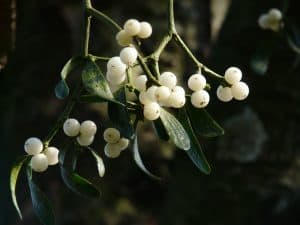 When? Spring and autumn are the ideal periods to plant their seeds in the garden, seeking the heat of the sun in the cold season and semi-shade in the warm season.
When? Spring and autumn are the ideal periods to plant their seeds in the garden, seeking the heat of the sun in the cold season and semi-shade in the warm season.- Where? This species that parasitizes other trees, is ideal for growing in gardens, especially in the cold winter season.
- How do we prepare the land? The soil must be deep and rich in humus, in organic matter and although it does not require much, this variety also requires very good drainage.
- How do we sow? Seeds should be planted in spring. But the birds are decisive in the cultivation and multiplication of this species, because when they eat the berry they carry the seeds on their wings, spreading them generously on other trees.
- How do we pay? It sucks all the sap from the tree where it parasitizes, which must receive organic and mineral fertilizers to stay healthy.
- When do they bloom? They bloom from March to May and in winter they become famous for their splendor, to the point that they serve as Christmas decorations.
- Ideal temperature? It likes cold temperatures and many varieties have their splendor in winter, but others adapt to heat, because they grow in full light.
- How do we water? It needs the plant that hosts it to have good humidity and the mistletoe itself must also receive watering at least twice a week.
- Diseases and pests? Actually, what can be a true pest is the mistletoe, capable of damaging the tree that feeds it, but it can suffer from insects, bacteria and fungi.
What is Mistletoe?
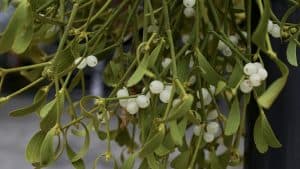 Few plants provide such an important service to human beings as mistletoe, with medicinal properties only comparable, perhaps, to the properties of Aloe vera.
Few plants provide such an important service to human beings as mistletoe, with medicinal properties only comparable, perhaps, to the properties of Aloe vera.
But mistletoe is a semi-parasitic plant that grows on the branches of different deciduous trees such as apple trees, poplars, and some pines, extracting the water and mineral salts that it requires for its sustenance.
It never hits the ground.
It maintains its green color throughout the year, it has long branches and its primary development is that of a small tree, but it can grow up to ten meters in height and four meters in diameter.
They have yellow female and male (dioecious) flowers , which after fertilization produce fruits in the form of small berries, green when young, but which become translucent (pinkish white) when mature and emit a viscous substance attached to their flesh.
This berry is consumed by birds, to which it sticks to the snout, so that when the bird flies to another tree, it leaves the seed imprinted there, an occasion that will serve for another mistletoe to fully develop in a few years. Therefore, it is popular all over the world.
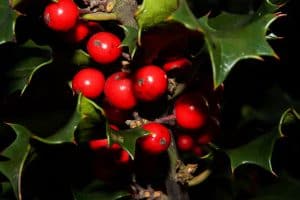 It is ideal for gardening, due to the singular beauty of its leaves and fruits that are displayed in all their splendor in the cold seasons. It is also widely used in Christmas festivities, as it is hung in the doorway for good wishes.
It is ideal for gardening, due to the singular beauty of its leaves and fruits that are displayed in all their splendor in the cold seasons. It is also widely used in Christmas festivities, as it is hung in the doorway for good wishes.
There are many varieties of mistletoe, some 1,500, but the most popular is the viscum album or white mistletoe, ringworm or lucky sprig.
Although its origin is European and Western Asia, it is also easily located in the American continent.
Its fame has transcended because, since ancient times, there is a tradition that every couple in love who is under a mistletoe must kiss to get love or keep the one they already have.
It is even used at weddings to wish the couple luck in their married life.
Aphrodisiac properties are also attributed to it, because since the Middle Ages it was supplied to women who wanted to get pregnant.
medicinal benefits of mistletoe
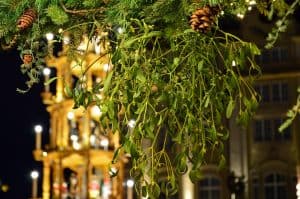 Among the healing attributes attributed to this curious plant, are the following:
Among the healing attributes attributed to this curious plant, are the following:
- It is used as a treatment to curb fever.
- It works for asthma and other respiratory diseases.
- It acts against renal colic and gallstones.
- It is used in the treatment of cancer. Its ability to eliminate free radicals and cells affected by breast cancer is currently being investigated.
- It has antirheumatic qualities and is also used to relieve various pains such as sciatica.
- It is used for the treatment of hypertension. because it lowers blood pressure levels.
But since nothing is perfect in the world, in the case of mistletoe, along with its medicinal benefits, we must put a warning message at the time of consumption: it contains viscotoxin, a substance that is harmful to humans.
According to the US National Cancer Institute, viscotoxins are small toxic proteins produced by mistletoe plants that are capable of destroying cells and can stimulate the immune system.
Where should we plant mistletoe?
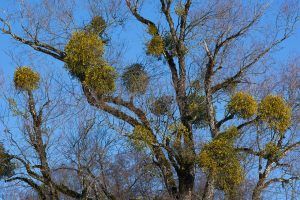 We can grow it in our garden, for which we must find white mistletoe seeds, but these seeds are not easy to obtain, due to their parasitic relationship with some species of trees, such as deciduous trees, apple trees, poplar trees and pines.
We can grow it in our garden, for which we must find white mistletoe seeds, but these seeds are not easy to obtain, due to their parasitic relationship with some species of trees, such as deciduous trees, apple trees, poplar trees and pines.
So other varieties of the hundreds that can be obtained in the market can be used.
When do we grow mistletoe?
In cold weather we should plant them in the sun and in hot weather it is better to do it in semi-shade.
It is recommended to do it in the spring or fall.
How do we prepare the land?
Mistletoe prefers deep, humus-rich, well-drained soils.
mistletoe multiplication
It reproduces by seeds and segments.
As we have explained, its seeds are sticky, so when a bird lands on it, it sticks to its beak and feathers, so that when the bird goes to another tree, the seed also germinates there.
How to plant mistletoe step by step?
Since holly is difficult to germinate, some experts recommend the following:
- Remove the meat from the fruits, leaving them to rot in a bowl of water, until fermentation.
- Then, we must wash the seeds until they are clean and make sure that they have dried completely.
- Once this process is completed, it is advisable to store them in the refrigerator at temperatures of five degrees Celsius, or put them in dry sand in a cold place to wait for spring.
The SAP
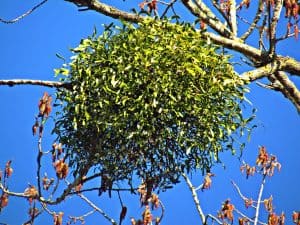 Mistletoe develops very slowly after germinating under the bark, as it only forms its first leaves in the second year.
Mistletoe develops very slowly after germinating under the bark, as it only forms its first leaves in the second year.
As each year it will form an additional floor, it is not difficult to determine its age; it sucks the raw sap of the tree that hosts it (water and mineral salts) and transforms it into elaborated sap itself.
It can also be sown directly into the ground in the fall, which is recommended. In the following spring a plant could be born, but its process is late, since it takes two or three years to grow.
What care does the mistletoe need?
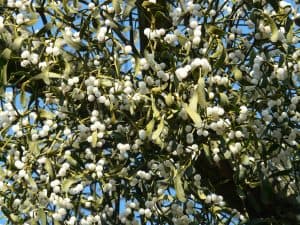 Many things have been written about the mistletoe, some beautifully fantastic, like the legend that it is born spontaneously when lightning strikes a tree.
Many things have been written about the mistletoe, some beautifully fantastic, like the legend that it is born spontaneously when lightning strikes a tree.
For this reason, in some parts of the planet, the mistletoe represents the union between Heaven and Earth.
One of the main cares is to carefully attend to the tree where the mistletoe lives as a tenant, if we want it to remain beautiful and healthy in our garden. Therefore, the resident tree needs a lot of foliage and moisture.
It is a plant that will grow in good conditions if it is watered twice a week. It supports pruning very well, so in some places it is used to form hedges.
However, if we have acquired a potted mistletoe and want to keep it that way, we must make sure that it does not lack water.
It is a plant that gets along well with the cold, but it should not lack light, although this should not be direct, much less sunlight.
What pests and diseases does it have?
The mistletoe is very sensitive to the attack of insects, bacteria and fungi, but it itself becomes a pest for the tree that hosts it, because by sucking the sap it can dry and destroy it, although this does not happen continuously.
Against fungi we can always use a natural fungicide or potassium soap.
Therefore, extreme precautions must be taken when maintaining it.

![Photo of Prune Lavender: [Importance, Season, Tools, Considerations and Steps]](https://www.complete-gardening.com/wp-content/uploads/2022/08/prune-lavender-importance-season-tools-considerations-and-steps-390x220.jpg)
![Photo of Celandine: [Cultivation, Irrigation, Care, Pests and Diseases]](https://www.complete-gardening.com/wp-content/uploads/2022/08/celandine-cultivation-irrigation-care-pests-and-diseases-390x220.jpg)
![Photo of Cultivate Passion Fruit in Spain: [Cultivation, Care, Pests and Diseases]](https://www.complete-gardening.com/wp-content/uploads/2021/06/Maracuya-en-Espana-390x220.jpg)
